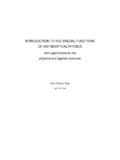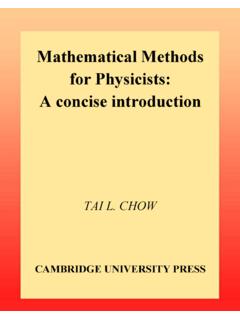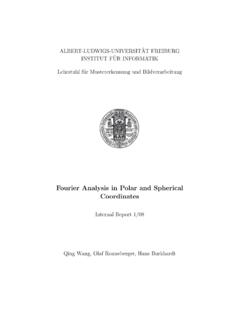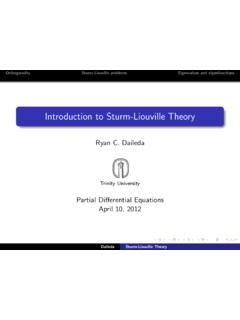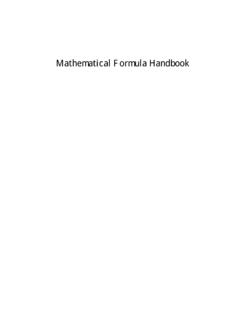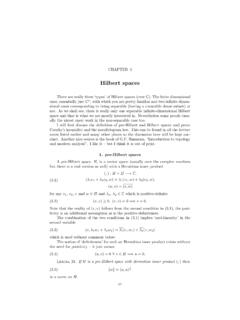Transcription of 1 Solutions in cylindrical coordinates: Bessel functions
1 Bessels 20201 Solutions in cylindrical coordinates: Bessel functionsLaplace s equation in cylindrical coordinates is:1 +1 1 + 2 z2=0 Separate variables: Let =R( )W( )Z(z).Then wefind:1R R +1W 2 2W 2+1Z 2Z z2=0 The last term is a function ofzonly, while the sum of thefirst two terms is afunction of and only. Thus we take each part to be a constant 2Z z2=k2 Zand the Solutions areZ=e kzThis is the appropriate solution outside of a charge distribution, say above aplane, ( 0asz ),or inside a cylinder with grounded walls andnon-zero potential on one remaining equation is:1R R +1W 2 2W 2+k2=0 Now multiply through by 2: R R +k2 2+1W 2W 2=0 Here the last term is a function of only and thefirst two terms are functionsof only. Again we often want a solution that is periodic with period2 ,sowe choose a negative separation constant: 2W 2= m2W W=e im Finally we have the equation for the function of : R +k2 2R m2R=01To see that this equation is of Sturm-Liouville form, divide through by : R +k2 R m2 R=0(1)Now we have a Sturm-Liouville equation (slreview notes eqn.)
2 1) withf( )= ,g( )=m2/ ,eigenvalue =k2and weighting functionw( )= .Equation (1)is Bessel s equation. The Solutions are orthogonal functions . Sincef(0) = 0,we do not need to specify any boundary condition at =0if our range is0 a,as is frequently the case. (We do specify thatRremainfinite.) Wedo need a boundary condition at = is simpler and more elegant to solve Bessel s equation if we change to thedimensionless variablex=k .Then:k k k R k +k2 R km2k R=0ddx xdRdx +xR m2xR=0 The equation has a singular point atx= we look for a series solution ofthe Frobenius type (cf Lea Chapter 3 ):R=xp [n=0anxnR3= [n=0(n+p)anxn+p 1ddx xdRdx = [n=0(n+p)2anxn+p 1 Then the equation becomes: [n=0(n+p)2anxn+p 1+ [n=0anxn+p+1 m2 [n=0anxn+p 1=0 The indicial equation is given by the coefficient ofxp 1:p2 m2=0 p= mThus one of the Solutions (withp=m)is analytic atx=0,and one (withp= m)isnot. Tofind the recursion relation, look at thek+p 1power ofx:(k+p)2ak+ak 2 m2ak=0and soak= ak 2(k+p)2 m2= ak 2k2+2kp+p2 m2= ak 2k2+2kp= ak 2k(k 2m)2 Let s lookfirst at the solution withp=+ we start the series witha0,thenkwill always be even,k=2n,anda2n= 12n(2n+2m) 1(2n 2) (2n 2+2m)a2n 4=( 1)323n(n 1) (n 2) 23(n+m)(n+m 1) (n+m 2)a2n 6=a0( 1)n2nn!]]]]]]
3 12n(n+m)(n+m 1) (m+1)The usual convention is to takea0=12m (m+1)(2)Thena2n=12m (m+1)( 1)n2nn!12n(n+m)(n+m 1) (m+1)=( 1)nn! (n+m+1)22n+m(3)and the solution is the Bessel function:Jm(x)= [n=0( 1)nn! (n+m+1) x2 m+2n(4)The functionJm(x)has only even powers ifmis an even integer and only oddpowers ifmis an odd integer. The series converges for all values s see what the second solution looks like. Withp= mthe recursionrelation is:ak=ak 2k(k 2m)(5)where againk= ifmis an integer we will not be able to determinea2mbecause the recursion relation blows up. One solution to this dilemma isto start the series we canfind the succeedinga2n:a2(n+m)= a2(n 1)+2m22(n+m)n= a2(n 2)+2m24(n+m)(n+m 1)n(n 1)=( 1)n (m+1)n! (n+m+1)22na2mwhich is the same recursion relation we had before. (Compare the equationabove with equation (3). Thus we do not get a linearly independent solutionthis way1. (This dilemma does not arise if the separation constant is taken tobe 2with non-integer.))]
4 In that case the second recursion relation provides1 This happens because the two roots of the indicial equation differ by an (x)that is linearly independent of thefirst.) Indeed wefind:J m(x)= [n=0( 1)n (m+1)n! (n+m+1)22na2mx2(n+m) m= [n=0( 1)n (m+1)2mn! (n+m+1)a2m x2 m+2nandifwechoosea2m=( 1)m (m+1)2mthenJ m(x)=( 1)mJm(x)(6)With this choiceJ (x)is a continuous function of .(Noticethatwecanalsoexpress the series using equation (3) for the coefficients, withm mandn k+m,and wherea2n 0forn<m.)We still have to determine the second, linearly independent solution of theBessel equation. We canfind it by taking the limit as mof a linearcombination ofJ andJ known as the Neumann functionN (x):Nm(x) = lim mN (x) = lim mJ (x)cos J (x)sin = lim 0Jm+ (x)cos(m+ ) J (m+ )(x)sin (m+ ) = lim 0Jm+ (x)(cosm cos sinm sin ) J (m+ )(x)sinm cos +cosm sin = lim 0Jm+ (x)( 1)mcos J (m+ )(x)( 1)msin Now we expand the functions tofirst order in.]]
5 We use a Taylor series for theBessel functions . Note that appears in the index, not the argument, so wehave to differentiate with respect to ..Nm(x) = lim 0Jm+ (x)( 1)m J (m+ )(x)( 1)m = lim 0( 1)m ( 1)m Jm+ dJ d =m J m+ dJ d =m Using relation (6), we have:Nm(x)=1 dJ d =m ( 1)mdJ d =m 4 The derivative has a logarithmic term:dJ d =dd %x [n=0( 1)nn! (n+ +1) x2 2n&=dx d [n=0( 1)nn! (n+ +1) x2 2n+x dd [n=0( 1)nn! (n+ +1) x2 2nanddx d =dd e lnx=lnxe lnx=x lnxand sodJ /dxhas a term containingJ term diverges asx 0provided thatJv(0)is not zero, for = functionNv(x)alsodiverges asx 0for 9=0,because it contains negative powers ofx.(Theseries forJ starts with a termx .)N isfinite asx becauseJ goesto zero sufficiently additional functions called Hankel functions are defined as linear com-binations ofJandN:H(1)m(x)=Jm(x)+iNn(x)(7)andH(2)m (x)=Jm(x) iNn(x)(8)Compare the relation between sine, cosine, and exponential:e ix=cosx Properties of the functionsThe Bessel functions (Js)are well behaved both at the origin and asx.]]]
6 They have infinitely many zeroes. All of them, except forJ0,are zero atx= few functions are shown in three Bessel ,J1(red) andJ25 For small values of the argument, we may approximate the function with thefirst term in the series:Jm(x) 1 (m+1) x2 mforx 1(9)The Neumann functions are not well behaved atx= a logarithmicsingularity, and form>0,Nmdiverges as an inverse power ofx:N0(x) 2 lnxforx 1Nm(x) (m 1)! 2x mforx 1,m>0(10)For large values of the argument, bothJandNoscillate: they are like dampedcosine or sine functions :Jm(x) u2 xcos x m 2 4 forx 1,m(11)Nm(x) u2 xsin x m 2 4 forx 1,m(12)and thus the Hankel functions are like complex exponentials:H(1,2)m u2 xexpk i x m 2 4 lforx 1,m(13)Notice that ifm>1,the large argument expansions apply forx mratherthan the usualx Relations between the functionsAs we found with the Legendre functions , we can determine a set of recursionrelations that relate successiveJm(x).For example (Lea )ddx Jm(x)xm = Jm+1(x)xm(14)which is valid form particular, withm=0we obtain:J1(x)= J30(x)(15)ddx(xmJm(x)) =xmJm 1(x)(16)From (14) and (16) we may obtainJm+1+Jm 1=2mxJm(17)and similarlyJm+1 Jm 1= 2dJmdx(18)The same relations hold for Orthogonality of theJmSince the Bessel equation is of Sturm-Liouville form, the Bessel functions areorthogonal if we demand that they satisfy boundary conditions of the form(slreview notes eqn 2).
7 In particular, suppose the region of interest is =0to =a,and the boundary conditions areJm(ka)= do not need aboundary condition at =0because the functionf( )= is zero there. Thenthe eigenvalues arekmn= mnawhere mnis thenth zero ofJm.(The zeros are tabulated in standard referencessuch as Abramowitz and Stegun. Also programs such as Mathematica andMaple can compute them.) Then]a0 Jm(kmn )Jm(kmn3 )d =a22[J3m(kmna)]2 nn3(19) Solving a potential cylinder of radiusaand heighthhas its curved surface and itsbottom grounded. The top surface has is the potential insidethe cylinder?The potential has no dependence on and so only eigenfunctions withm=0contribute. The potential is zero at =a,sothesolutionweneedisJ0(k )witheigenvalues chosen to makeJ0(ka)= the eigenvalues are given byk0na= 0n,where 0nare the zeros of the remaining functionofzmust be zero atz=0,sowechoosethehyperbolicsine. Thusthepotentialis: ( ,z)= [n=1anJ0(k0n )sinh(k0nz)Now we evaluate this atz=h:V= ( ,h)= [n=1anJ0(k0n )sinh(k0nh)Next we make use of the orthogonality of the Bessel functions .]
8 Multiply bothsides by J0(k0r )and integrate from 0 toa.(Note here that the weight functionw( )= .This is thefirsttimewehaveseenaweightfunctiontha tisnot1.)Only one term in the sum, withn=r,survives the ]a0 J0(k0r )d =]a0 J0(k0r ) [n=1anJ0(k0n )sinh(k0nh)d =ar]a0 [J0(k0r )]2d sinh (k0rh)=ara22[J30(k0ra)]2sinh (k0rh)7To evaluate the left hand side, we use equation (16) withm=1:]a0 J0(k )d =1k]a0ddk (k J1(k ))d =1k J1(k )|a0=akJ1(ka)Soar=Vak0rJ1(k0ra)2a2[J30(k 0ra)]2sinh (k0rh)=Vk0ra2J1(k0ra)sinh(k0rh)whereweus edtheresultfromequation(15)thatJ30= our solutionis: =2V [n=1J0( 0n /a) 0nJ1( 0n)sinh ( 0nz/a)sinh ( 0nh/a)Thefirst two zeros ofJ0are: 01= , 02= , and thus thefirsttwo terms in the potential are: =2V#J0 a ( )sinh sinh +J0 a ( )sinh sinh + $ Modified Bessel functionsSuppose we change the potential problem so that the top and bottom of thecylinder are grounded but the outer wall at =ahas potentialV( ,z).Thenwe would need to choose a negative separation constant so that the Solutions ofthez-equation are trigonometric functions : 2Z z2= k2Z Z=asinkz+bcoskzAtz=0,Z(z)=0,so we need the sine, and therefore setb= also needZ(h)=0,so we choose the eigenvaluek=n change in sign of the separation constant also affects the equation forthe functionR( )because the sign of thek2term changes.
9 R k2 R m2 R=0or, changing variables tox=k : x x R x xR m2xR=0(20)8which is called themodified Bessel equation. The Solutions to this equationareJm(ik ).It is usual to define the modified Bessel functionIm(x)by therelation:Im(x)=1imJm(ix)(21)so that the functionImis always real (whether or notmis an integer). Usingequation (4) we can write a series expansion forIm:Im(x)=1im [n=0( 1)nn! (n+m+1) ix2 m+2n= [n=01n! (n+m+1) x2 m+2n(22)As with theJs, ifmis an integer,I mis not independent ofIm:in fact:I m(x)=imJ m(ix)=im( 1)mJm(ix)=( 1)mi2mIm(x)=Im(x)(23)The second independent solution is usually chosen to be:Km(x)= 2im+1H(1)m(ix)(24)Then these functions have the limiting forms:Im(x) 1 (m+1) x2 mforx 1(25)andK0(x) lnx2forx 1(26)Km(x) (m)2 2x mform>0,x 1(27)At largex, x 1,m, the asymptotic forms are:Im(x) 1 2 xex(28)andKm(x) u 2xe x(29)(cf Lea Chapter 3 Example ) These functions , like the real exponentials,do not have multiple zeros and are not orthogonal functions .]]
10 Note that theIsare well behaved at the origin but diverge at infinity. For theKs,the reverseis true. They diverge at the origin but are well behaved at infinity (Seefigurebelow). ,KModified Bessel Blackm=0,Blue1,Red2 The recursion relations satisifed by the modified Bessel functions are similarto, but not identical to, the relations satisfied by theJs. For theIs, again wecan start with the series:ddx Imxm =12m [n=01n! (n+m+1) x2 2n=12m [n=1nn! (n+m+1) x2 2n 1 Now letk=n 1:ddx Imxm =12m [k=01k! (k+m+2) x2 2k+1=1xm [k=01k! (k+m+2) x2 2k+m+1ddx Imxm =Im+1(x)xm(30)and similarlyddx(xmIm)=xmIm 1(31)Expanding out and combining, we get:2I3m=Im+1+Im 12mxIm=Im 1 Im+1(32)10 For theKs, the relations are:ddx(xmKm)= xmKm 1;ddx Km(x)xm = Km+1(x)xmand consequently:Km 1 Km+1= 2mxKmKm 1+Km+1= 2K3m(33) Combining functionsWhen solving a physics problem, we start with a partial differential equation anda set of boundary conditions. Separation of variables produces a set ofcoupledordinary differential equations in the various coordinates.]]]]





